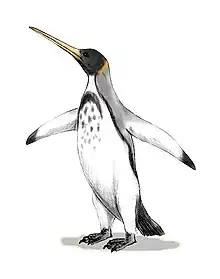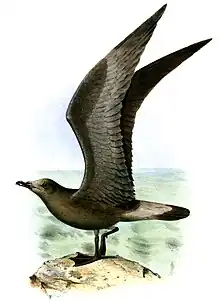| Polynesian storm petrel | |
|---|---|
| Scientific classification | |
| Domain: | Eukaryota |
| Kingdom: | Animalia |
| Phylum: | Chordata |
| Class: | Aves |
| Order: | Procellariiformes |
| Family: | Oceanitidae |
| Genus: | Nesofregetta Mathews, 1912 |
| Species: | N. fuliginosa |
| Binomial name | |
| Nesofregetta fuliginosa (Gmelin, JF, 1789) | |
| Synonyms[2] | |
|
Fregetta ampitrite Jardin, 1859 | |
The Polynesian storm petrel (Nesofregetta fuliginosa) is a species of seabird in the family Oceanitidae. It is the only species placed in the genus Nesofregetta.
Markedly polymorphic, several subspecies were described, and light birds were even considered a species on their own (white-throated storm-petrel). Not even subspecies are generally accepted today, however.
It is found in Chile, French Polynesia, Kiribati, New Caledonia, Vanuatu, possibly American Samoa, possibly Fiji, and possibly Samoa.
Its natural habitats are open seas, rocky shores, and sandy shores. It is threatened by introduced predators in its nesting areas.
Taxonomy
The Polynesian storm petrel was formally described in 1789 by the German naturalist Johann Friedrich Gmelin in his revised and expanded edition of Carl Linnaeus's Systema Naturae. He placed it with the other petrels in the genus Procellaria and coined the binomial name Procellaria fuliginosa.[3] Gmelin based his description on the "sooty petrel" that had been described in 1785 by the English ornithologist John Latham in his book A General Synopsis of Birds.[4] The Polynesian storm petrel is now the only species placed in the genus Nesofregetta that was introduced in 1912 by the Australian born ornithologist Gregory Mathews.[5][6] The name combines the Ancient Greek nēsos meaning "island" and Fregetta, a genus name that was introduced by Charles Lucien Bonaparte in 1855 for the storm petrels. The specific epithet fuliginosa is from Late Latin fuliginosus meaning "sooty".[7] The species is monotypic: no subspecies are recognised.[6]
References
- ↑ BirdLife International (2018). "Nesofregetta fuliginosa". IUCN Red List of Threatened Species. 2018: e.T22698471A132649758. doi:10.2305/IUCN.UK.2018-2.RLTS.T22698471A132649758.en. Retrieved 16 November 2021.
- ↑ Mayr, Ernst; Cottrell, G. William, eds. (1979). Check-List of Birds of the World. Vol. 1 (2nd ed.). Cambridge, Massachusetts: Museum of Comparative Zoology. p. 110.
- ↑ Gmelin, Johann Friedrich (1789). Systema naturae per regna tria naturae : secundum classes, ordines, genera, species, cum characteribus, differentiis, synonymis, locis (in Latin). Vol. 1, Part 2 (13th ed.). Lipsiae [Leipzig]: Georg. Emanuel. Beer. p. 562.
- ↑ Latham, John (1785). A General Synopsis of Birds. Vol. 3, Part 2. London: Printed for Leigh and Sotheby. p. 409, No. 15.
- ↑ Mathews, Gregory M. (1912). The Birds of Australia. Vol. 2. London: Witherby. p. 31.
- 1 2 Gill, Frank; Donsker, David; Rasmussen, Pamela, eds. (August 2022). "Petrels, albatrosses". IOC World Bird List Version 12.2. International Ornithologists' Union. Retrieved 12 November 2022.
- ↑ Jobling, James A. (2010). The Helm Dictionary of Scientific Bird Names. London: Christopher Helm. pp. 269, 165. ISBN 978-1-4081-2501-4.
External links
- Species factsheet - BirdLife International


